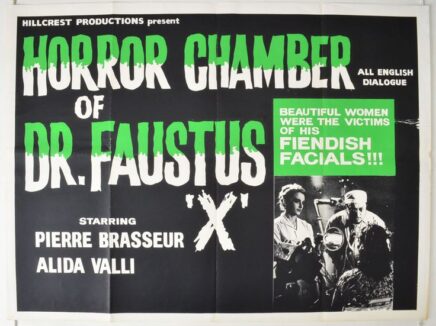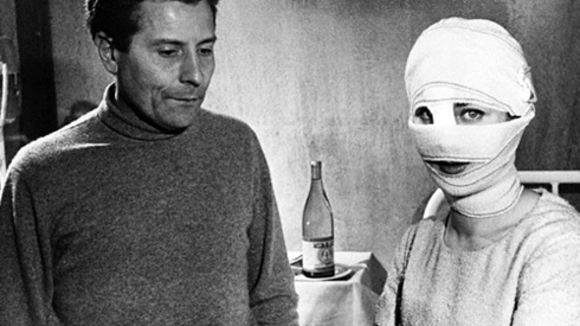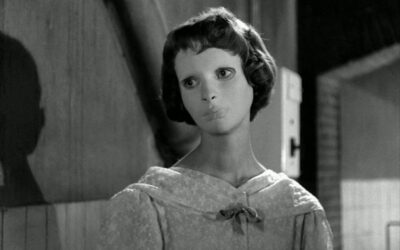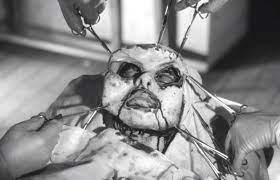It’s a cherished belief held by people throughout the world that American moviegoers can’t handle subtitled films. Not true, but the misconception can be forgiven due to the fact that so many non-American films have been released on these shores in dubbed and retitled versions.
One key example: THE HORROR CHAMBER OF DR. FAUSTUS, prepared by Lopert Pictures and producer William Shelton, and released (on a famous double feature with the Lopert/Shelton production THE MANSTER) in 1962. Shelton was known for bowdlerizing foreign films (such as the acclaimed 1963 Turkish drama SUSUZ YAZ, which Shelton turned into DRY SUMMER), and with the crassly titled HORROR CHAMBER OF DR. FAUSTUS he wreaked his wiles on the 1960 French horrorfest LES YEUX SANS VISAGE, or EYES WITHOUT A FACE.
Shelton was known for bowdlerizing foreign films (such as the acclaimed 1963 Turkish drama SUSUZ YAZ, which Shelton turned into DRY SUMMER), and with the crassly titled HORROR CHAMBER OF DR. FAUSTUS he wreaked his wiles on the 1960 French horrorfest LES YEUX SANS VISAGE, or EYES WITHOUT A FACE.
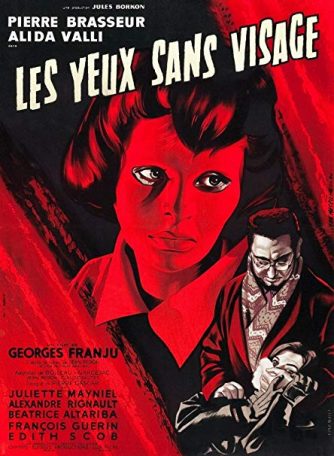 That film (Eyes Without a Face), the masterpiece of the great Georges Franju (1912-1987), was adapted from a Jean Redon novel by Boileau-Narcejac (a.k.a. Pierre Boileau and Thomas Narcejac). It centers on one Dr. Génessier (Pierre Brasseur), whose daughter Christiane’s face was horrifically deformed in a car crash, leading to her wearing a featureless white mask. As visualized by the luminous black and white cinematography of Eugen Schüfftan, the sight of the mask-wearing Christiane ranks as one of the most quietly haunting in the film history (and reportedly inspired the white mask worn by Michael Myers in HALLOWEEN).
That film (Eyes Without a Face), the masterpiece of the great Georges Franju (1912-1987), was adapted from a Jean Redon novel by Boileau-Narcejac (a.k.a. Pierre Boileau and Thomas Narcejac). It centers on one Dr. Génessier (Pierre Brasseur), whose daughter Christiane’s face was horrifically deformed in a car crash, leading to her wearing a featureless white mask. As visualized by the luminous black and white cinematography of Eugen Schüfftan, the sight of the mask-wearing Christiane ranks as one of the most quietly haunting in the film history (and reportedly inspired the white mask worn by Michael Myers in HALLOWEEN).
…the sight of the mask-wearing Christiane ranks as one of the most quietly haunting in the film history (and reportedly inspired the white mask worn by Michael Myers in HALLOWEEN).
Christiane’s father has his creepy-yet-seductive assistant Louise (Alida Valli), whose own face was repaired by the not-so-good doctor, kidnap young women whose faces he removes and grafts onto the head of his daughter—who emerges after his latest attempt as the strikingly beautiful Edith Scob (a Franju regular). But this facial grafting, as with the previous attempt, doesn’t take, leading to a still photo montage showing Scob’s face in various stages of regression. Clearly Génessier will have to find another unwitting donor whose face will be (literally) lifted, but this attempt proves his undoing.
Franju presents Génessier’s face peeling process in an extraordinarily graphic sequence that still startles today. All the slicing and bleeding may seem at odds with the ethereal air that colors the rest of the film, but its style is consistent throughout, with the lingering close-ups and methodical arrangement of the facial removal—inspired in large part by the surreal-tinged documentaries of Franju’s fellow countryman Jean Painlevé, particularly 1930’s THE CORRECTIVE AND RECONSTRUCTIVE SURGERY OF DR. CLAOU/Chirugie corrective et réparatrice du Dr. Claoué, whose close-up heavy depiction of eyeball surgery reportedly made Luis Bunuel vomit—being crucial components of Franju’s filmmaking aesthetic.
Yet even more important than the visuals is the use of sound. The score by Maurice Jarre, with its quirky melodical refrain, makes for an interesting counter-punctual accompaniment, although even more affecting is Franju’s use of silence. The music-less quiet that accompanies the facial removal, and also an early bit in which Brasseur enters his house and ascends a staircase, lend the images a deeply ominous frisson.
EYES WITHOUT A FACE was poorly received upon its initial release (a critic for THE SPECTATOR was nearly fired for liking it) but has gone on to become not only the quintessential example of poetic horror cinema but also, it seems, the beginning and end of its director’s oeuvre. Of Franju’s other films (which include the 1962 thriller THERESE DESQUEYROUX and the 1963 Louis Feuillade pastiche JUDEX), only the notorious documentary short THE BLOOD OF THE BEASTS/Le Sang des Bêtes (1949), which relentlessly depicts the day-to-day occurrences in a slaughterhouse in the form of a warped fairy tale, appears to be widely remembered.
EYES WITHOUT A FACE was poorly received upon its initial release (a critic for THE SPECTATOR was nearly fired for liking it) but has gone on to become not only the quintessential example of poetic horror cinema but also, it seems, the beginning and end of its director’s oeuvre.
What isn’t widely remembered is THE HORROR CHAMBER OF DR. FAUSTUS, although that wasn’t always the case. In the 1980s and 90s American home video market the William Shelton prepared version of Franju’s film, difficult though it might seem to believe these days, was readily available than via a Sinister Cinema VHS. It wasn’t until 1996, when a restored print of EYES WITHOUT A FACE was theatrically released in the US, that the situation began to be reversed, a process completed with the Criterion Collection DVD in 2004.
The English dubbing aside (which isn’t bad), the changes wrought by Shelton are subtle, but they add up. Roughly six minutes were shorn from the initial 90-minute runtime, and many of those minutes occur, surprisingly given Shelton’s exploitive bent (from the poster: “Beautiful women were the victims of his FIENDISH FACIALS!!!”), in the face lifting sequence. Several cuts also occur in the hospital set climax, in which Dr. Génessier’s tender side is shown in his attention to a sickly young boy who doesn’t appear in the HORROR CHAMBER version. We also get trims to Franju’s many lingering close-ups, and added music and chirping bird ambiance played over scenes that in EYES take place in eerie silence.
The English dubbing aside (which isn’t bad), the changes wrought by Shelton are subtle, but they add up.
The result of all these changes is a disaffected and exploitive film that Clive Barker, a huge fan of EYES, dismissed as “bastardized and terrible.” Author Barry Atkinson went even farther, accusing Shelton of “pandering to the drive-in, sensation-seeking brigade rather than a discerning clientele who would appreciate the movie for what it really was.” I say the situation is a bit more complex than the “EYES WITHOUT A FACE good-HORROR CHAMBER OF DR. FAUSTUS bad” dichotomy those quotes suggest.
HORROR CHAMBER is certainly the more overtly surreal of the two films. Franju was known to consort with surrealists, a group that, let’s not forget, rejected artiness and affectation, as reflected in their disparagement of the overtly poetic cinema of Jean Epstein, whose FALL OF THE HOUSE OF USHER/La chute de la maison Usher (1928) is quite complimentary to EYES WITHOUT A FACE (as opposed to the more cynical and black humored films of Luis Bunuel, who worked as a production assistant on USHER and spent much of the rest of his life disparaging the film and its maker).
Yet the surrealists quite enjoyed potboilers, and THE HORROR CHAMBER OF DR. FAUSTUS, with its B movie façade that has the effect of enhancing the strangeness of the material, would seem right up the surrealist alley. The aforementioned surrealist-affiliated documentarian Jean Painlevé, a key influence on Franju, was known for the tonal dissonance of his films (in which, among other oddities, undersea footage was accompanied by bouncy circus-appropriate music), and tonal dissonance is a defining aspect of HORROR CHAMBER.
With such bizarre material, sometimes it’s the non-artistic approach that works best. In this sense THE HORROR CHAMBER OF DR. FAUSTUS’ lack of artistry functions in its favor, with some elements, such as the still photo montage of Edith Scob’s decomposing face, working better here than they did in the original version.
I’m not saying HORROR CHAMBER is better than its antecedent, just that it deserves a closer look than it’s thus far received. Then again, though, maybe I am saying THE HORROR CHAMBER OF DR. FAUSTUS is superior to EYES WITHOUT A FACE, as in recent years I’ve been finding myself returning more and more to that Sinister Cinema VHS, while my Criterion DVD continues to gather dust.

